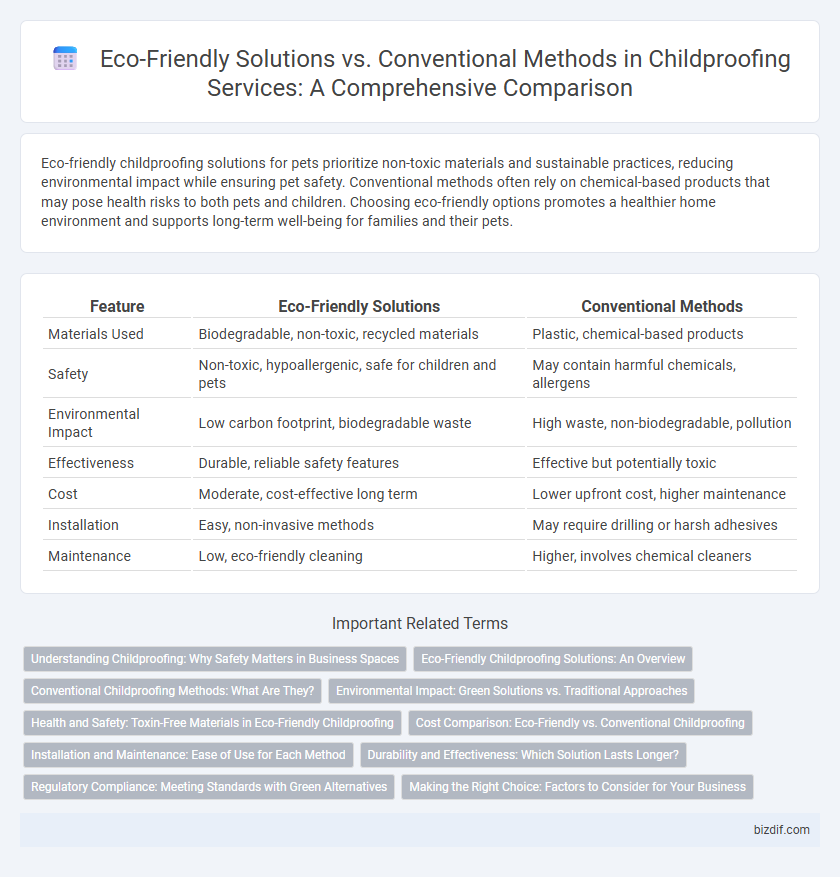Eco-friendly childproofing solutions for pets prioritize non-toxic materials and sustainable practices, reducing environmental impact while ensuring pet safety. Conventional methods often rely on chemical-based products that may pose health risks to both pets and children. Choosing eco-friendly options promotes a healthier home environment and supports long-term well-being for families and their pets.
Table of Comparison
| Feature | Eco-Friendly Solutions | Conventional Methods |
|---|---|---|
| Materials Used | Biodegradable, non-toxic, recycled materials | Plastic, chemical-based products |
| Safety | Non-toxic, hypoallergenic, safe for children and pets | May contain harmful chemicals, allergens |
| Environmental Impact | Low carbon footprint, biodegradable waste | High waste, non-biodegradable, pollution |
| Effectiveness | Durable, reliable safety features | Effective but potentially toxic |
| Cost | Moderate, cost-effective long term | Lower upfront cost, higher maintenance |
| Installation | Easy, non-invasive methods | May require drilling or harsh adhesives |
| Maintenance | Low, eco-friendly cleaning | Higher, involves chemical cleaners |
Understanding Childproofing: Why Safety Matters in Business Spaces
Eco-friendly childproofing solutions incorporate non-toxic materials and sustainable practices that reduce harmful chemical exposure while maintaining effective safety standards in business spaces. Conventional methods often rely on synthetic chemicals and plastics that can off-gas toxins, posing potential health risks to children and employees. Prioritizing green childproofing not only safeguards children's well-being but also aligns with corporate social responsibility goals and environmental sustainability initiatives.
Eco-Friendly Childproofing Solutions: An Overview
Eco-friendly childproofing solutions utilize non-toxic, sustainable materials such as organic cotton, bamboo, and natural wood to ensure a safe environment without harmful chemicals. These methods often involve biodegradable products and low-VOC (volatile organic compound) paints, reducing indoor air pollution and minimizing environmental impact. Choosing eco-friendly childproofing supports healthier homes for children while promoting environmental responsibility and long-term sustainability.
Conventional Childproofing Methods: What Are They?
Conventional childproofing methods primarily involve the use of plastic outlet covers, metal cabinet locks, and foam corner guards to prevent injuries. These solutions often rely on synthetic materials and chemical adhesives, which may pose environmental and health concerns due to their non-biodegradable nature and potential toxins. Despite their widespread availability and lower upfront cost, conventional methods lack sustainability compared to eco-friendly alternatives made from natural or recycled materials.
Environmental Impact: Green Solutions vs. Traditional Approaches
Eco-friendly childproofing solutions use non-toxic, biodegradable materials that reduce chemical exposure and minimize environmental pollution, unlike conventional methods often reliant on plastics and harmful adhesives. These green alternatives also promote sustainability by incorporating recycled and renewable resources, lowering carbon footprints associated with production and disposal. Choosing eco-friendly childproofing not only safeguards children's health but also supports a cleaner, safer planet for future generations.
Health and Safety: Toxin-Free Materials in Eco-Friendly Childproofing
Eco-friendly childproofing solutions prioritize the use of toxin-free materials such as non-toxic paints, natural wood, and BPA-free plastics, significantly reducing harmful chemical exposure to children. Conventional methods often rely on synthetic materials and chemical coatings that may emit volatile organic compounds (VOCs), posing health risks like respiratory issues and skin irritation. Choosing eco-friendly childproofing enhances indoor air quality and promotes a safer environment for infants and toddlers by minimizing the presence of hazardous substances.
Cost Comparison: Eco-Friendly vs. Conventional Childproofing
Eco-friendly childproofing solutions often involve non-toxic materials and sustainable products, which may have a higher upfront cost compared to conventional methods using plastic or chemical-based items. Over time, eco-friendly options can result in cost savings through durability and reduced health-related expenses due to fewer harmful substances. Conventional childproofing methods tend to offer lower initial prices but may require more frequent replacements and pose potential risks, leading to higher long-term costs.
Installation and Maintenance: Ease of Use for Each Method
Eco-friendly childproofing solutions prioritize the use of sustainable, non-toxic materials that often feature modular designs for quick, tool-free installation and minimal maintenance requirements, reducing long-term environmental impact and ensuring safety. Conventional methods typically involve synthetic materials and hardware that can require more complex installation processes, including screws and adhesives, which may demand regular upkeep or replacement over time due to wear and potential chemical degradation. Choosing eco-friendly options enhances ease of use with simple, user-friendly installation while offering durable, low-maintenance safety features aligned with health-conscious family environments.
Durability and Effectiveness: Which Solution Lasts Longer?
Eco-friendly childproofing solutions often utilize sustainable materials such as bamboo or recycled plastics, offering durability comparable to conventional methods made from synthetic plastics and metals. Studies show that eco-friendly options resist wear and tear effectively while reducing chemical exposure, making them both safe and long-lasting. Conventional childproofing products may degrade faster under certain conditions, but eco-friendly alternatives typically provide a robust, environmentally responsible option without compromising performance.
Regulatory Compliance: Meeting Standards with Green Alternatives
Eco-friendly childproofing solutions adhere to stringent regulatory compliance by utilizing non-toxic, sustainable materials that meet or exceed safety standards set by agencies like the CPSC and ASTM. These green alternatives avoid harmful chemicals found in conventional methods, reducing health risks and environmental impact while ensuring child safety. Choosing eco-friendly options supports regulatory mandates and promotes a safer, greener home environment for children.
Making the Right Choice: Factors to Consider for Your Business
Choosing eco-friendly childproofing solutions over conventional methods involves evaluating factors such as material safety, environmental impact, and long-term cost efficiency. Businesses should consider the non-toxic properties of eco-friendly products, which reduce health risks for children while aligning with sustainable practices that appeal to eco-conscious customers. Assessing durability, ease of installation, and compliance with safety regulations ensures the selected solutions provide effective protection without compromising environmental responsibility.
Eco-Friendly Solutions vs Conventional Methods Infographic

 bizdif.com
bizdif.com